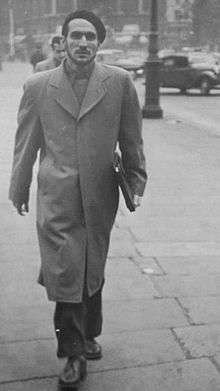Shakir Hassan Al Said

Shakir Hassan Al Said (Arabic: شاكر حسن ال سعيد) (1925–2004), an Iraqi painter, sculptor and writer, is considered one of Iraq's most innovative[1] and influential[2] artists.
Biography
Born in Samawa,[3] Al Said lived, worked and died in Bagdad.[4] He received in 1948 a degree in social science from the Higher Institute of Teachers in Baghdad and in 1954 a diploma in painting from the Institute of Fine Arts in Baghdad where he was taught by Jawad Saleem.[5] He continued his studies at the École nationale supérieure des Beaux-Arts in Paris until 1959,[6] where he was taught by Raymond Legueult.[7] During his stay in Paris, he discovered Western modern art in galleries and Sumerian art at the Louvre.[2] After his return to Baghdad in 1959, Al Said studied the work of Yahya ibn Mahmud al-Wasiti,[1] sufism[2] and Mansur Al-Hallaj.[8] He gradually abandoned figurative expressions and centered his compositions on Arabic calligraphy.[1][2]
He co-founded in 1951 with Jawad Saleem Jama'et Baghdad lil Fann al-Hadith (Baghdad Modern Art Group), one of the most unusual arts movements in the Middle East in the post–World War II,[9] that aimed to achieve an artistic approach both modern and embracing of tradition.[10] This specific approach was called Istilham al-turath (Seeking inspiration from tradition), considered as "the basic point of departure, to achieve through modern styles, a cultural vision".[2][11] He headed the group after the death of Saleem in 1961.[12]
In 1971, he founded Al Bu'd al Wahad (the One-dimension Group)",[6] which promoted the modern calligraphic school in Arab art.[7]
His work is collected by major museums, such as Mathaf: Arab Museum of Modern Art in Doha, the Guggenheim in New York, and Sharjah Art Museum.
References
- 1 2 3 Mikdadi, Salwa. "West Asia: Between Tradition and Modernity". Metropolitan Museum of Art. Retrieved August 22, 2011.
- 1 2 3 4 5 Shabout, Nada (May 2008). "Shakir Hassan Al Said: A Journey towards the One-dimension". Nafas. Retrieved August 22, 2011.
- ↑ Khatibi, Abdelkebir (2001). L'art contemporain arabe: prolégomènes (in French). Al Manar. p. 23. ISBN 978-2-913896-11-6.
- ↑ "Shaker Hassan Al Said". Kinda Foundation. Retrieved August 22, 2011.
- ↑ Bahrani, Zainab; Shabout, Nada M. (2009). Modernism and Iraq. Miriam and Ira D. Wallach Art Gallery, Columbia University in the City of New York. p. 97.
- 1 2 "Shaker Hassan Al Said". Darat al Funum. Retrieved August 22, 2011.
- 1 2 Bloom, Jonathan; Blair, Sheila (2009). The Grove encyclopedia of Islamic art and architecture. Oxford University Press. p. 165. ISBN 978-0-19-530991-1.
- ↑ Wilson-Goldie, Kaelen (March 21, 2005). "Paying tribute to an Iraqi master before his legacy disappears". Daily Star. Retrieved August 22, 2011.
- ↑ Ghareeb, Edmund; Dougherty, Beth (2004). Historical dictionary of Iraq. Scarecrow Press. p. 35. ISBN 978-0-8108-4330-1.
- ↑ Secor, Beth (January 13, 2009). "'Iraqi Artists in Exile' Showcase Their Haunting Works". Houston Press. Retrieved August 22, 2011.
- ↑ Dakhlia, Jocelyne; Depaule, Jean-Charles (2006). Créations artistiques contemporaines en pays d'islam: des arts en tensions. Kimé. p. 286. ISBN 978-2-84174-402-2.
- ↑ Shabout, Nada M. (2007). Dafatir. University of North Texas School of Visual Arts. p. 16. ISBN 978-1-889886-08-4.
External links
- Shakir Hassan Al Said timeline
- Some works by Shakir Hassan Al Said (in Arabic)
- More works by Shakir Hassan Al Said